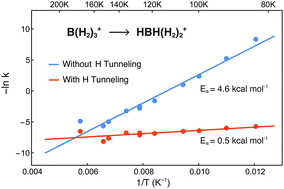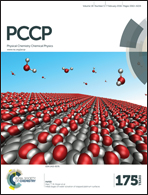σ Bond activation through tunneling: formation of the boron hydride cations BHn+ (n = 2, 4, 6)†
Abstract
The network of H2 additions to B+ and subsequent insertion reactions serve as a tractable model for hydrogen storage in elementary boron-containing compounds. Here, they are investigated using state-of-the-art ab initio methods (up to CCSDTQ and cc-pCV6Z basis sets). The binding energies of H2 to HBH+ (14.9 kcal mol−1) and HBH(H2)+ (18.1 kcal mol−1) are determined to be much higher than those for B(H2)+ (3.8 kcal mol−1), B(H2)2+ (3.0 kcal mol−1), and B(H2)3+ (2.5 kcal mol−1) at the CCSDTQ/CBS level of theory. These predictions are in agreement with the experiments of Kemper, Bushnell, Weis, and Bowers (J. Am. Chem. Soc., 1998, 120, 7577). Molecular orbital analyses show that the enhanced binding in HBH(H2)m+ complexes originates from the strong interaction between the 1σu HOMO of HBH+ and the 1σu LUMO of H2. For the insertion reactions B(H2)n+ → HBH(H2)n−1+, activation barriers are determined to be 58.3 kcal mol−1 [Mk-MRCCSD(T)/CBS], 12.2 kcal mol−1 (CCSDTQ/CBS) and 4.6 kcal mol−1 (CCSDTQ/CBS) for n = 1, 2, and 3, respectively. After using theoretical results to remove tunneling effects from the experimental rate constants, new Arrhenius fits yield activation barriers of 4.6(3) kcal mol−1 and 3.8(1) kcal mol−1 for the BH6+ and BD6+ insertion reactions, respectively, which are in near perfect agreement with converged theoretical values (4.6 kcal mol−1 and 3.9 kcal mol−1). These findings demonstrate that earlier Arrhenius fits considerably underestimate these barriers, and that quantum tunneling dominates the σ bond activation mechanism witnessed in previous experiments involving BH6+.


 Please wait while we load your content...
Please wait while we load your content...